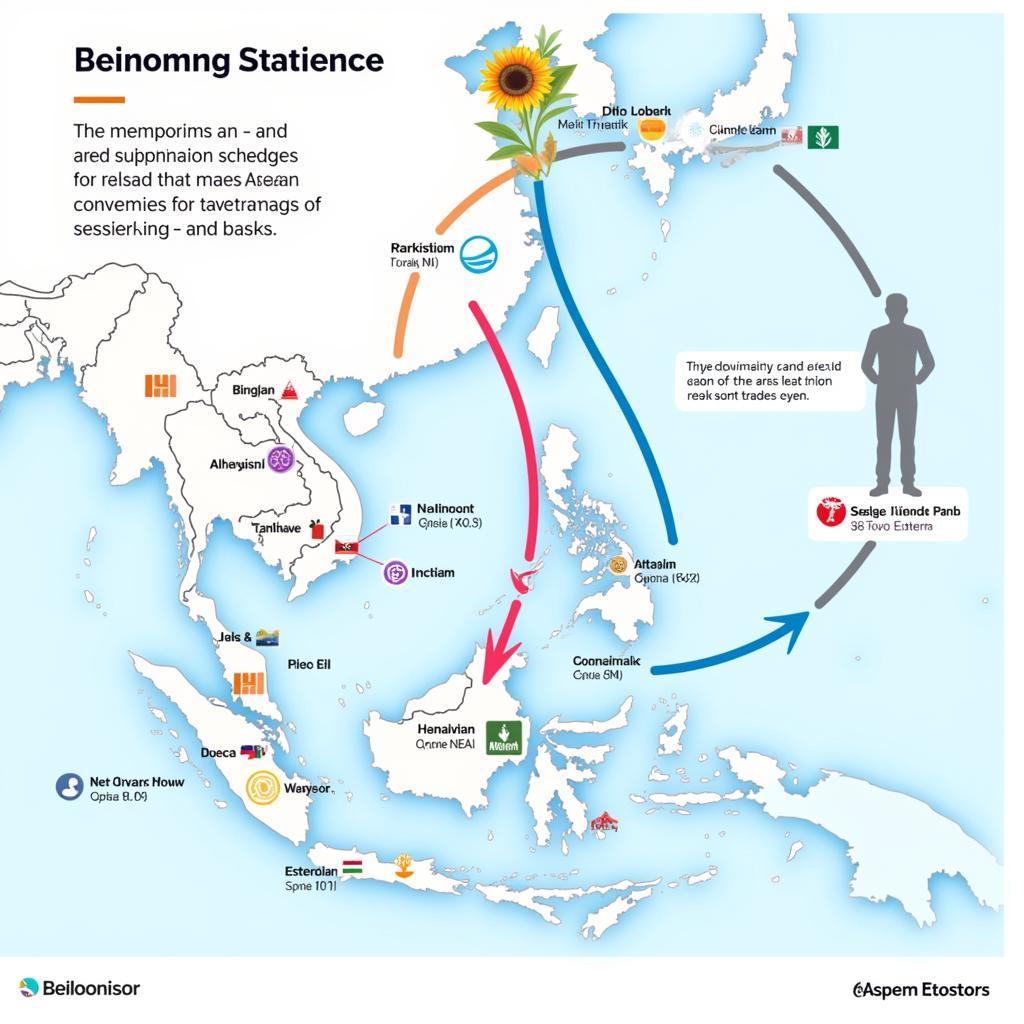The Association of Southeast Asian Nations (ASEAN) stands as a testament to regional cooperation and integration. At its heart lie the ASEAN missions, guiding principles that shape the organization’s actions and aspirations. Understanding “les missions de l’ASEAN” is crucial to grasping the profound impact this organization has on Southeast Asia and the world.
Pillars of Progress: Delving into ASEAN’s Core Missions
ASEAN’s missions are multifaceted, encompassing political, economic, and socio-cultural spheres. These missions are not merely abstract ideals; they translate into concrete actions and initiatives that drive the region forward.
1. Economic Integration: Fostering a Dynamic and Interconnected Region
ASEAN recognizes that economic prosperity is essential for peace and stability. A cornerstone mission is the establishment of the ASEAN Economic Community (AEC), aiming to create a single market and production base. This ambitious endeavor involves:
- Eliminating trade barriers: ASEAN actively reduces tariffs and non-tariff barriers to facilitate the free flow of goods, services, and investments within the region.
- Enhancing connectivity: Infrastructure development, particularly in transport and communication, is prioritized to bridge physical gaps and promote seamless connectivity.
- Facilitating trade and investment: ASEAN works towards streamlining customs procedures and harmonizing regulations to attract foreign direct investment and boost intra-ASEAN trade.
 ASEAN Economic Integration
ASEAN Economic Integration
2. Political Security: Maintaining Peace and Stability in a Complex Region
ASEAN’s commitment to political and security cooperation is rooted in the shared understanding that a secure and stable environment is paramount for growth and development. Key initiatives include:
- Dialogue and diplomacy: ASEAN promotes peaceful resolution of disputes through dialogue, consultation, and consensus-building among member states.
- Preventive diplomacy: The organization actively engages in preventive diplomacy efforts to address potential conflicts and maintain regional stability.
- Combating transnational crime: Recognizing the interconnected nature of security threats, ASEAN collaborates closely to combat transnational crimes such as terrorism, drug trafficking, and human trafficking.
 ASEAN Security Cooperation
ASEAN Security Cooperation
3. Socio-Cultural Cooperation: Nurturing a Shared Identity and Promoting Inclusivity
ASEAN acknowledges that true integration goes beyond economics and politics; it requires fostering a sense of community and shared identity. Key aspects of socio-cultural cooperation include:
- Promoting cultural exchange: ASEAN encourages cultural exchanges, educational programs, and people-to-people interactions to enhance understanding and appreciation of the region’s rich cultural diversity.
- Empowering women and youth: Recognizing the vital role of women and youth in development, ASEAN implements programs to empower them through education, skills development, and leadership opportunities.
- Environmental protection: ASEAN is committed to addressing environmental challenges collectively, promoting sustainable development practices, and conserving the region’s natural resources.
ASEAN’s Enduring Impact: A Catalyst for Positive Change
The ASEAN missions, far from being static, are constantly evolving to address emerging challenges and seize new opportunities. They serve as a compass, guiding the organization’s actions and shaping its future direction. The success of ASEAN in achieving its missions is evident in:
- Increased intra-regional trade and investment: The AEC has significantly boosted trade and investment flows within Southeast Asia, creating jobs and driving economic growth.
- Enhanced regional stability: ASEAN’s commitment to dialogue and cooperation has contributed to a more peaceful and stable Southeast Asia, even amidst complex geopolitical dynamics.
- A stronger regional identity: ASEAN’s socio-cultural initiatives have fostered a greater sense of community and shared identity among the people of Southeast Asia.
Conclusion: ASEAN’s Missions – A Beacon for a Brighter Future
Understanding “les missions de l’ASEAN” is essential for comprehending the organization’s profound impact on Southeast Asia and the world. ASEAN’s unwavering commitment to its missions has transformed the region, fostering peace, stability, and prosperity. As ASEAN continues to evolve, its missions will remain a guiding force, shaping a brighter future for Southeast Asia and beyond.
FAQ
1. What are the three pillars of the ASEAN Community?
The three pillars of the ASEAN Community are the ASEAN Political-Security Community, the ASEAN Economic Community, and the ASEAN Socio-Cultural Community.
2. How does ASEAN promote peace and stability?
ASEAN promotes peace and stability through dialogue, consultation, consensus-building, and preventive diplomacy.
3. What is ASEAN’s role in promoting economic integration?
ASEAN promotes economic integration through initiatives such as the ASEAN Economic Community (AEC), which aims to create a single market and production base.
4. How does ASEAN address socio-cultural issues?
ASEAN addresses socio-cultural issues by promoting cultural exchange, empowering women and youth, and addressing environmental challenges.
5. What is the significance of ASEAN’s missions?
ASEAN’s missions provide a roadmap for the organization’s actions and guide its efforts to achieve its goals of peace, stability, and prosperity.
Need Assistance? Contact Us!
For any inquiries or support regarding ASEAN, please reach out to us:
Phone: 0369020373
Email: [email protected]
Address: Thon Ngoc Lien, Hiep Hoa, Bac Giang, Vietnam
Our dedicated customer support team is available 24/7 to assist you.

